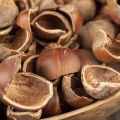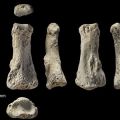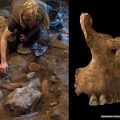
Oldest plant artefact found outside Africa reveals Pacific's role in early human migration
A new archaeological study led by the University of Oxford in collaboration with Universitas Gadjah Mada has identified the oldest plant artefact made by our species outside of Africa in a cave in West Papua. This suggests that the earliest Pacific seafarers arrived in West Papua over 55,000–50,000 years ago, introducing to the region complex plant processing and maritime skills. The findings have been published this week in the journal Antiquity.

Despite the Pacific’s critical importance for global population movements, scientists have not yet been able to pin down exactly when and where early humans travelled on their journey into the region. At this time, the Earth was in an Ice Age, meaning that sea levels were lower: the large continental shelves around Asia (called Sunda) and Australia (called Sahul) were exposed as dry land, but many of the islands of Southeast Asia remained islands.
Our species — Homo sapiens — may have moved along a “northern route” from what is now Borneo into Sulawesi, Maluku, and then West Papua, or a “southern route” from present-day Java and Bali to Flores, Timor, and then Australia (see map below). Previous research has hinted that seafarers arrived to Sahul perhaps as early as 65,000 years ago, while other archaeologists insist that these maritime crossings did not take place until after 50,000 years ago.
This new study, carried out on Waigeo Island1 in West Papua, off the coast of Ice Age Sahul, provides the first detailed evidence for the earliest stage of human arrival along the northern route into the Pacific. The findings demonstrate that Waigeo was an important stepping stone visited by the first seafarers. At this time Waigeo was part of a larger “palaeo-island” which the research team have named Waitanta2. This palaeo-island split into a series of smaller islands including Waigeo at the end of the Ice Age, when sea levels rose. Computer modelling and chemical isotope studies carried out by the researchers show that Waitanta contained patches of rainforest and a large valley system, and it was separated from Sahul by a deep-sea strait only a few kilometres wide.

The team’s excavations at a large cave site called Mololo3, in the interior of ancient Waitanta, uncovered rare evidence for human settlement and behaviour, including animal bones and a small rectangular tree resin artefact. The latter was directly dated at the University of Oxford’s radiocarbon accelerator to show it is 55,000–50,000 years old and the oldest plant artefact made by our species outside of Africa.
The researchers believe the artefact was produced in a multistep process by cutting the bark of a resin-producing tree, allowing it to harden, and then snapping it into shape, possibly to use it as a fuel source for fires inside Mololo cave (see image below). ‘The use of complex plant processing indicates these humans were sophisticated, highly mobile, and able to devise creative solutions to living on small tropical islands’ concluded Professor Daud Tanudirjo of Universitas Gadjah Mada, the co-director of the study.

The research team are continuing their archaeological research in West Papua, in the form of a large project funded by National Geographic that seeks to understand how early people adapted to the Pacific region and changed their behaviours in response to past climate change. For updates, see raja-ampat-arch.com or follow @DylanGaffneyNZ on Twitter/X.
The study ‘Human dispersal and plant processing in the Pacific 55,000–50,000 years ago’ has been published in Antiquity.
Explanation of place names:
1. Waigeo, meaning the sea inside or the water inside, named for its inland bay.
2. Waitanta, from Wai = water and Tanta = that stretches before your eyes. This is based on the islands of Waigeo and Batanta which were connected during the last Ice Age.
3. Mololo, meaning the place where the currents come together, since it is an area of choppy water and whirlpools.

 Oxford Humanities team delivers framework for tackling modern slavery and human trafficking
Oxford Humanities team delivers framework for tackling modern slavery and human trafficking
 Nearly 500,000 children could die from AIDS-related causes by 2030 without stable PEPFAR programmes, Oxford experts estimate
Nearly 500,000 children could die from AIDS-related causes by 2030 without stable PEPFAR programmes, Oxford experts estimate
 Expert Comment: Why has Trump launched so many tariffs and will it cause a recession?
Expert Comment: Why has Trump launched so many tariffs and will it cause a recession?
 Seeing the wood for the trees: using hazelnuts to reconstruct ancient woodlands
Seeing the wood for the trees: using hazelnuts to reconstruct ancient woodlands
 Ancient bones suggest first humans travelled further than we think
Ancient bones suggest first humans travelled further than we think
 Oldest DNA from Africa offers clues to ancient cultures
Oldest DNA from Africa offers clues to ancient cultures